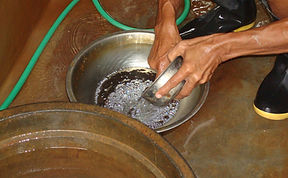Artisanal & Small-Scale Gold Mining (ASGM)

What is ASGM?
The term artisanal and small-scale gold mining (ASGM) describes any informal and often illegal gold mining operation. ASGM is common-place in developing nations of world, and has become more prevalent in recent years as gold has increased in value.
Most artisanal miners do not make large profits. Usually the gold buyers or bosses benefit from 'golden pay days'. But each miner is thought to generate income for a further 10 people, and this means that ASGM represents a significant source of income for some of the world’s poorest people. The World Bank has recognised that small mines can be a major source of revenue for rural communities, and can provide income for investment. However, operations are often illegal and/or poorly regulated. Miners may have no title to the land they are working, and there is no incentive or provision for sustainable land or waste management. Environmental destruction is the most visible outcome of artisanal mining.
Using mercury to recover gold from rock has traditionally been the technology of choice for ASGM miners (known as amalgamation). But amalgamation can be inefficient, and a significant amount of mercury is lost to the environment. The use and cycling of mercury at ASGM locations has been extensively studied. Commentators believe that in the order of 1,000 tonnes of mercury per year is released to the environment due to ASGM.
The traditional place of mercury in ASGM may be under threat. In January 2013 the United Nations wrapped up several years of negotiations to define a legally binding treaty on mercury use and pollution. A consequence of the negotiations has been an increase in the international market price for mercury. For miners in some countries, amalgamation is no longer an affordable technology. Perhaps for ASGM the act of negotiating the treaty has achieved the intended result.
In place of mercury, ASGM miners now look to cyanide for gold recovery. Cyanidation is the main process technology used by mining companies around the word for gold recovery from rock. Cyanidation may reduce mercury use in ASGM, but cyanide will also complex with other heavy metals in the rock during processing. If the waste from cyanidation is not properly managed, this waste (tailings) can also lead to pollution of the environment.
ASGM in West Nusa Tenggara Province, Indonesia
ASGM has been practiced on the Indonesian islands of Kalimantan, Sulawesi and parts of Java for many years. In 2008 operations began on the island of Lombok in West Nusa Tenggara Province (WNT). In 2010 operations began on the adjacent island of Sumbawa.
The product of amalgamation at ASGM: a mercury gold amalgam



